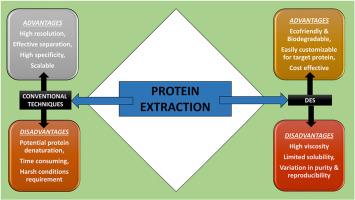利用深共晶溶剂重新定义从各种来源提取和分离蛋白质的前景
IF 15.1
1区 农林科学
Q1 FOOD SCIENCE & TECHNOLOGY
引用次数: 0
摘要
背景传统蛋白质提取方法中使用的传统有机溶剂会产生大量有毒废物,并导致蛋白质变性。由于近年来对蛋白质的需求不断增加,需要用更安全的溶剂来取代有机溶剂。深共晶溶剂(DES)因其高效、低成本、易制备和生态友好的特性而被视为新型绿色溶剂。众所周知,DES 具有可调的溶解能力和生物相容性。本综述讨论了 DESs 在分离和提取蛋白质(包括植物蛋白、动物蛋白和食品蛋白)中的适用性和效率方面的最新见解。本研究强调了 DES 在克服使用有机溶剂/盐所带来的弊端方面所起的作用,即保持蛋白质的稳定性和特性、变性以及降低提取蛋白质的生物活性。还可以考虑应用基于 DES 的水性双相系统,以改善提取过程和产量。主要发现和结论DES 已成为蛋白质提取过程中有毒溶剂的可行替代品,具有无与伦比的性能和前景。然而,从各种来源中提取蛋白质仍然困难重重,原因在于 HBA & HBD 生成 DES 的选择、它们的摩尔比、与蛋白质的相互作用、生物降解性和保持蛋白质结构的能力。对这些因素的详细研究有助于建立工业规模的高效提取工艺。本文章由计算机程序翻译,如有差异,请以英文原文为准。

Redefining the landscape of protein extraction and separation from various sources using deep eutectic solvents
Background
The conventional organic solvents used in traditional protein extraction methods produce huge amount of toxic waste and are also responsible for protein denaturation. Because of the increasing need for protein in recent times, organic solvents need to be replaced with safer solvents. Deep Eutectic Solvents (DESs) have been considered as newer green solvents due to their enhanced effectiveness, lower cost, easy preparation and eco-friendly nature. DESs are known for tunable solvation power and biocompatibility. DESs have the ability to extract protein with better extraction efficiency and higher yield.
Scope and approach
This review discusses up-to-date insights into the applicability and efficiency of DESs in the separation and extraction of proteins, including plant proteins, animal proteins and food proteins. It emphasizes the role of DES to overcome the downsides of using organic solvents/salts in view of preserving the stability and identity of proteins, denaturation and loss of biological activity of extracted proteins. The application of DES-based aqueous biphasic systems can also be considered for better extraction processes and yields.
Key findings and conclusions
DESs have emerged as viable alternative to toxic solvents for protein extraction, offering unparalleled performance and promise. However, protein extraction from a variety of sources is still difficult because of the choice of HBA & HBD for DES formation, their molar ratio, interaction with proteins, biodegradability and ability to preserve protein structure. A detailed study of these factors can help to build an efficient extraction process on an industrial scale.
求助全文
通过发布文献求助,成功后即可免费获取论文全文。
去求助
来源期刊

Trends in Food Science & Technology
工程技术-食品科技
CiteScore
32.50
自引率
2.60%
发文量
322
审稿时长
37 days
期刊介绍:
Trends in Food Science & Technology is a prestigious international journal that specializes in peer-reviewed articles covering the latest advancements in technology, food science, and human nutrition. It serves as a bridge between specialized primary journals and general trade magazines, providing readable and scientifically rigorous reviews and commentaries on current research developments and their potential applications in the food industry.
Unlike traditional journals, Trends in Food Science & Technology does not publish original research papers. Instead, it focuses on critical and comprehensive reviews to offer valuable insights for professionals in the field. By bringing together cutting-edge research and industry applications, this journal plays a vital role in disseminating knowledge and facilitating advancements in the food science and technology sector.
 求助内容:
求助内容: 应助结果提醒方式:
应助结果提醒方式:


